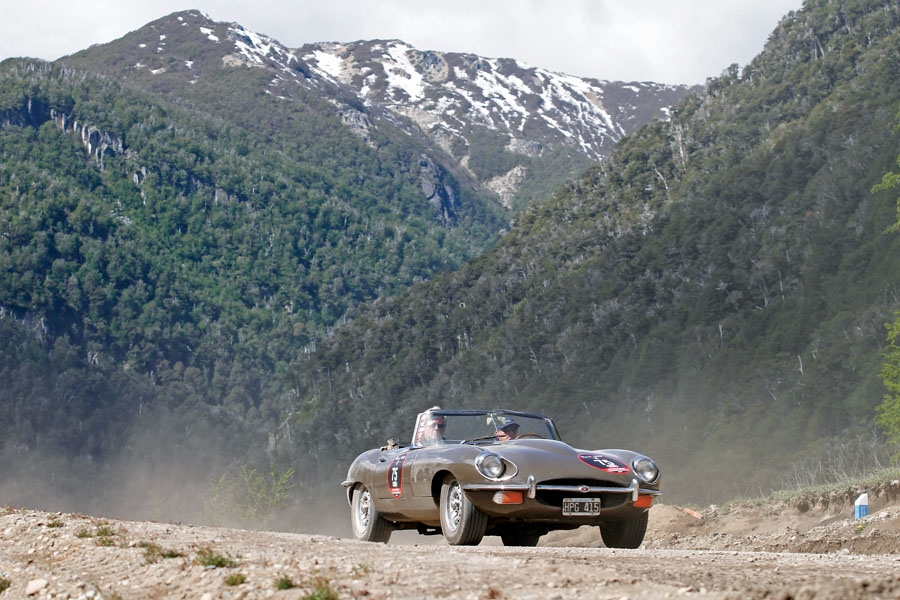
We had just crested the 4,311-foot Cardenal Antonio Samoré Pass, crossing from Argentina into Chile. The 1969 Series 1.5 Jaguar XKE we were driving was performing brilliantly.
It was a clear day, and we were surrounded by the snow-covered peaks of the Andes.
This was the second day of the 26th Annual 1000 Millas Sport de la República Argentina — the premier classic-car rally in South America. SCMer Martin Sucari introduced me to this rally eight years ago. This year, the Club de Automóviles Sport, which hosts the rally, invited me back for another go.
Damian Pozzoli graciously provided us with the Jaguar, which was trucked to the starting point, Bariloche, from Buenos Aires. It had covered just 50,000 km since new, and was still wearing its original paint and well-patinated interior. Driving it would prove to be an extraordinary experience, as it was a nicely kept used car. The E-types I have driven before have either been worn-out claptraps — or fully restored examples that have lost their souls. (Damian drove his 1933 Aston Martin Le Mans Special on the rally.)
I’d never had a former U.S. Navy carrier pilot as a navigator before. I was slightly concerned that Dean Koehler would start barking out orders and expect me to eject upon command as we sped through the mountains. I kept a tight grip on the wheel — just in case he was thinking of commandeering it.
As we motored along, I thought back to all of the road trips I’ve been on. I have long maintained that old cars are just magic keys that unlock certain experiences. Over the years, I’ve had a lot of keys open a lot of two-lane padlocks. Having the E-type in Patagonia was yet another visit to another Magic Kingdom.
Why we do this
For someone who’s not a car fanatic, a vintage rally doesn’t make much sense. You drive a sometimes-unreliable and probably uncomfortable car long distances — often over bumpy, curvy roads.
You depart early — our start time was around 8 a.m. each day — and end 10 hours later. You proceed through good weather and bad.
I recall one wet day on the California Mille, driving my 1958 Giulietta Spider Veloce vintage racer. The Alfa had a cut-down racing windscreen, so the raindrops simply beat straight onto my face at 70 mph.
I thought it was a great day, and I was dry before dinner. Not necessarily warm, but dry. I still value that memory of driving an old car in ridiculous weather conditions and being surrounded by others doing exactly the same thing. It’s nice when all of the inmates from the asylum escape at the same time — and head in the same direction.
The Millas had more than 80 timed sections called “Monte Carlos” interspersed throughout the 1,000-mile route. You had to complete each one of these in a specified time, and you were measured in 1/100s of a second. Maximum timing penalties were assessed after a two-second error.
Was this our idea of fun? Of course it was.
Llao Llao, Malbec and champagne
By day three, Dean and I were veterans. We knew that the champagne reception at the magnificent host hotel, the Llao Llao, would begin at 7:30 p.m. The sumptuous dinners started at 9 p.m., and wouldn’t conclude much before 11 p.m. The 6:30 a.m. wakeup time meant we knew we wouldn’t get enough sleep. We knew not to eat too much at lunch — or we’d both be afternoon snoozers somewhere along the route.
We also quickly moved from ignorant-class to novice-category rally drivers.
Fellow SCMers Tom Smith and Don Polak were at the event, driving a Volvo 544 they had purchased on Bring a Trailer. Koehler was especially delighted to meet them, as he is the founder and benevolent dictator of the Round-Fendered Volvo Club in Portland. He has an 1800E and an ES in his stable. SCM has two Volvos in its collection as well — a 122S and an 1800S, so we four SCMers went around acting like wannabe Vikings. If only we could have found an IKEA in Patagonia for some pickled herring snacks.
Unlike some vintage events, where only vintage rally calculators are allowed, the Millas is an electronic free-fire zone. Smith had advised Koehler to download the app “Chronomaster” and he was able to pre-load the times for all of the day’s special sections into it. (Tom’s story about the Millas will appear in the next issue.)
Koehler, through his sterling navigation, managed to move us slowly up through the standings. We were 79th out of 123 competitors at the end of Day One, and we were 57th at the finish.
We accumulated 6,626 penalty points. The overall winners, Juan Tonconogy and Barbara Ruffini, driving a 1936 Riley Sprite, had just 403 penalty points over the 1,000 miles, meaning they were just four seconds off from perfect at the end of the event.
Did our finishing position really matter? On one hand, of course not. On the other, each time we moved up a notch in the standings, we basked in the glow of conquest.
There’s something special about being in a string of old cars, on great roads through magnificent scenery. When you’re staring at a Gullwing through your windshield, and see a 280SL in your rearview mirror, it’s as if you have been transported to a magical world from which ordinary cars are prohibited.
The next morning, the ball was over and it was time to return our double-overhead-cam glass slipper. As our flight left Patagonia, we looked down at the Andes and watched the chapter close on another great memory-making road trip. ♦